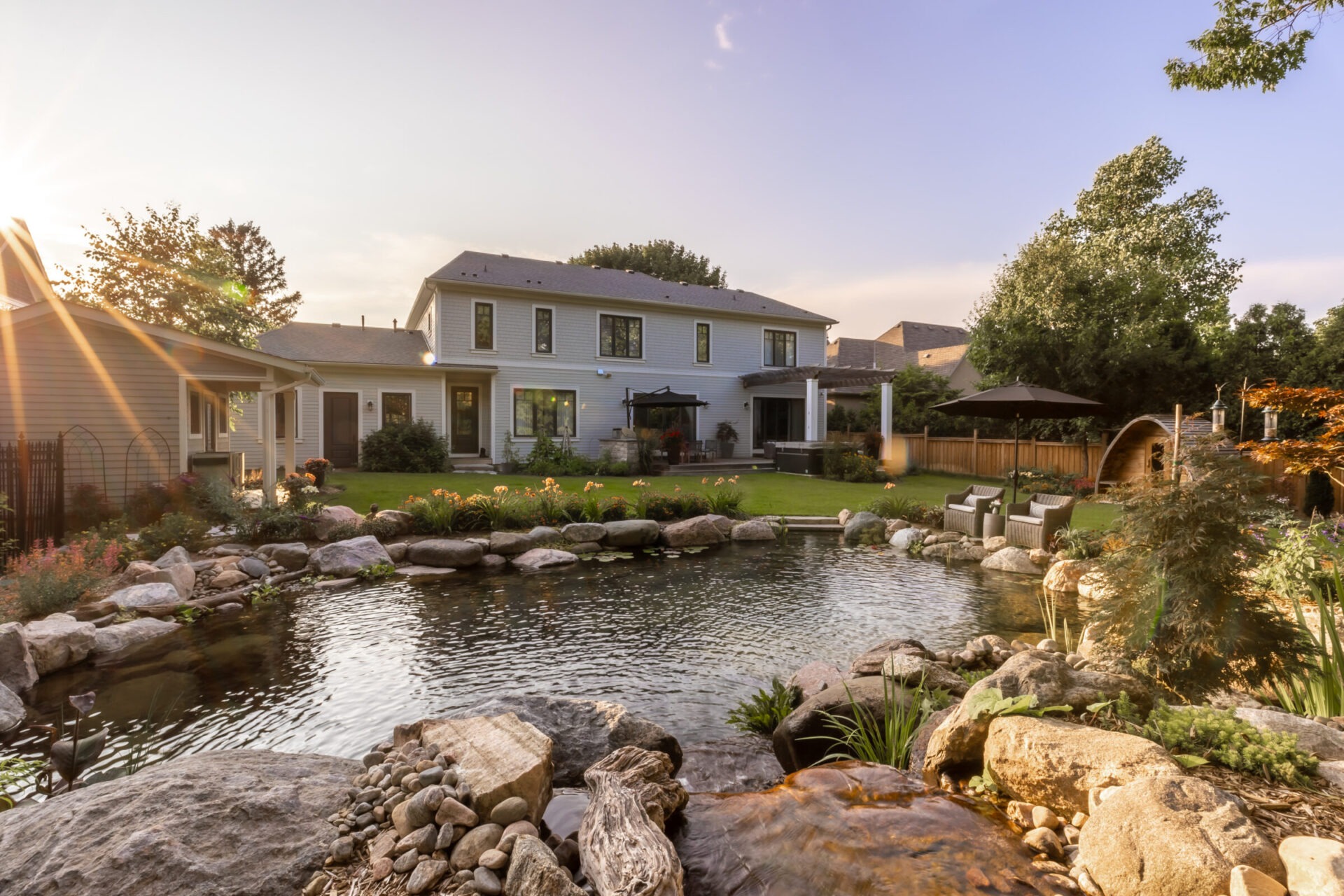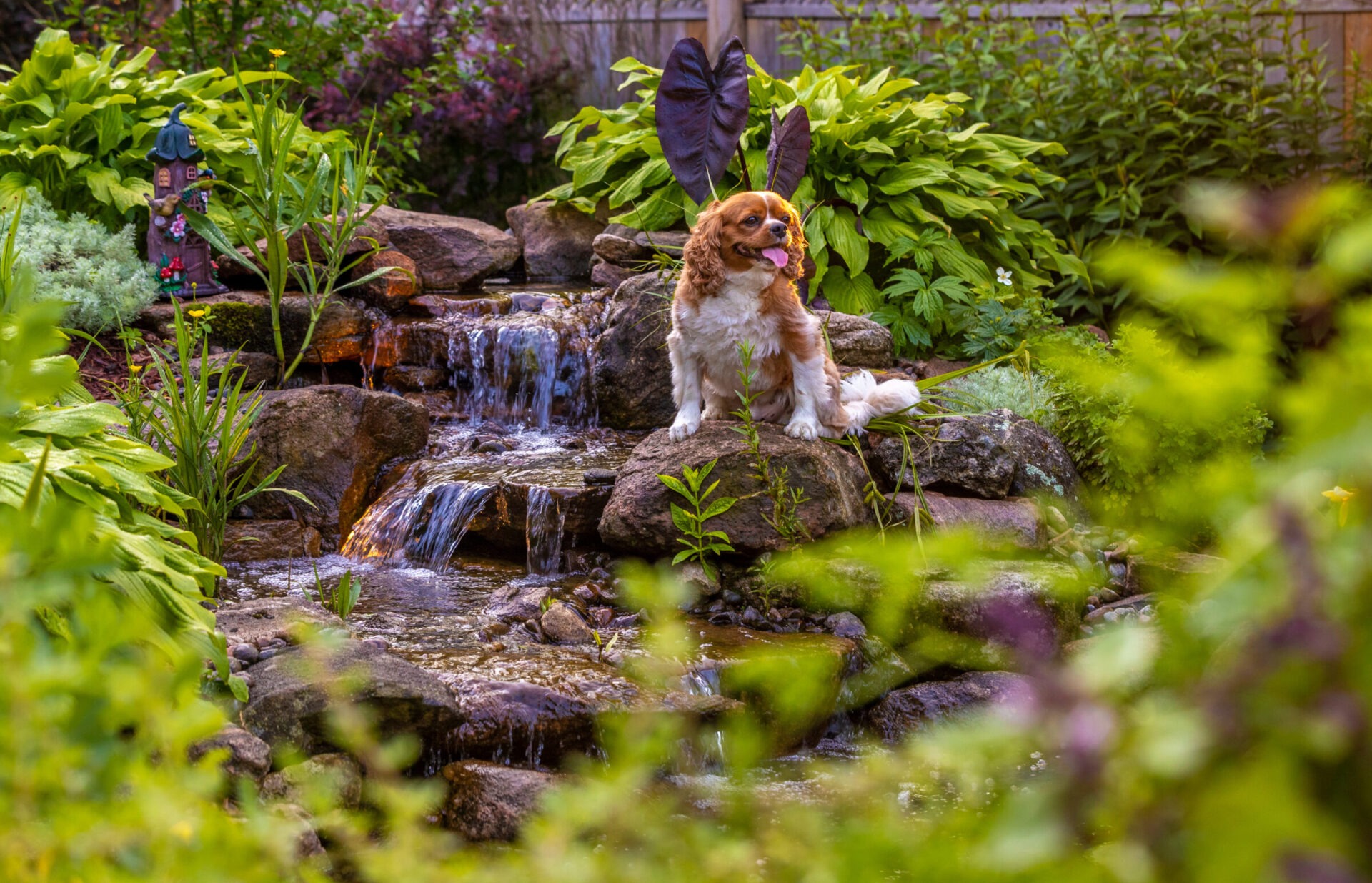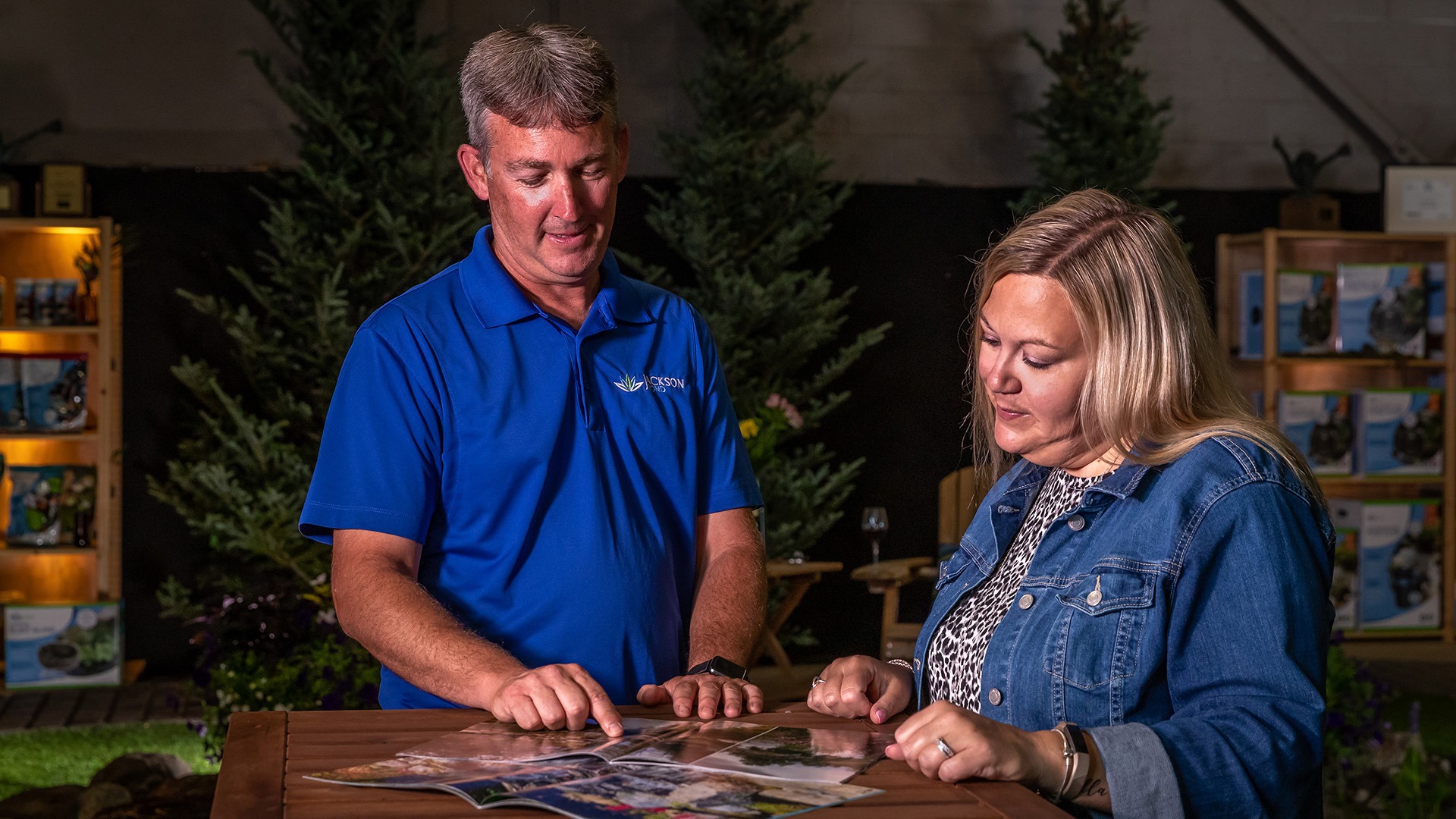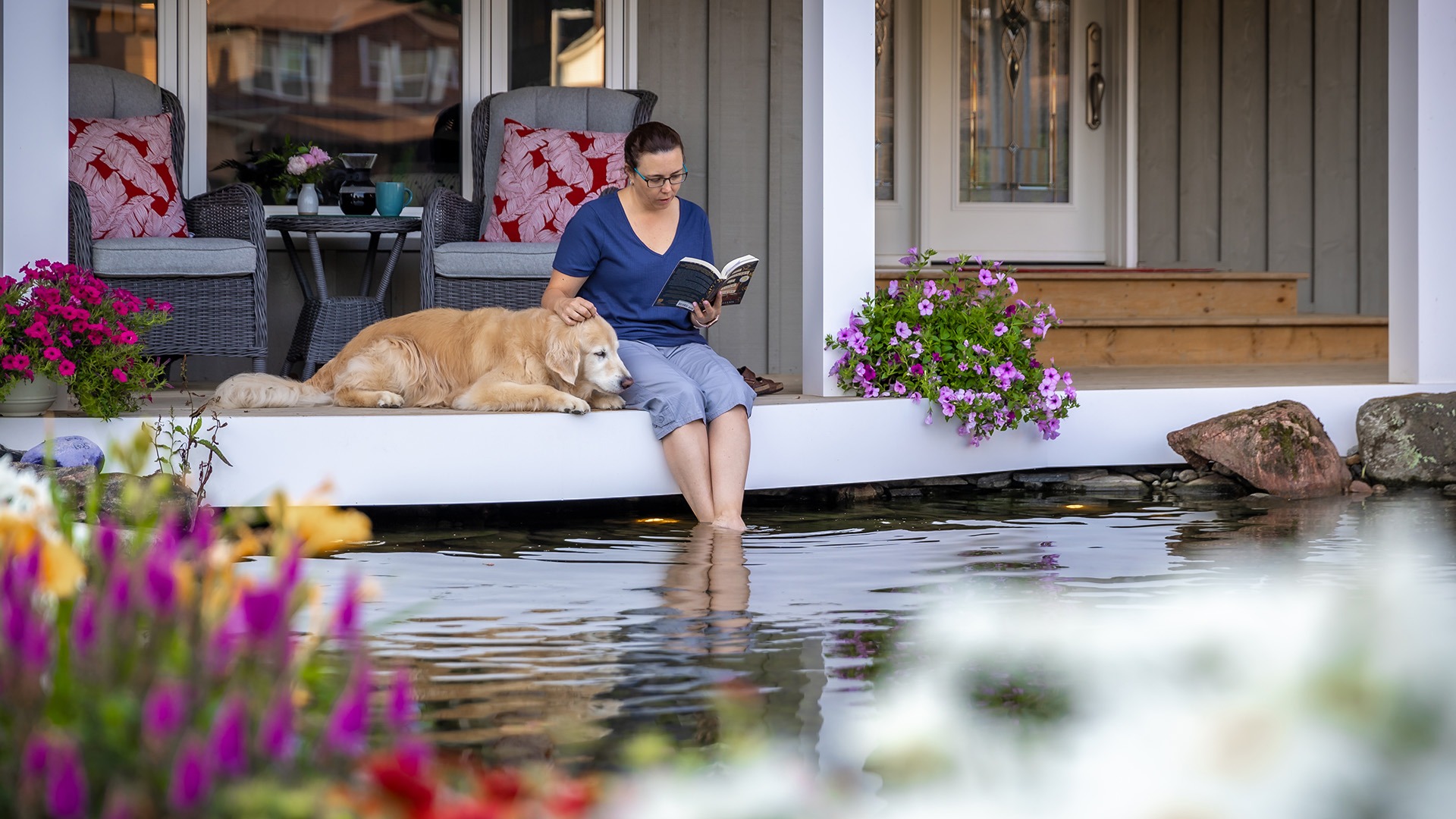The Ultimate Guide to Backyard Ponds and Waterfalls in Ontario

Transforming your outdoor space starts with water. The gentle sound of a cascading waterfall. The shimmer of koi beneath lily pads. The year-round beauty of a custom-built pond. For many Ontario homeowners, a well-designed water feature isn’t just a backyard upgrade — it’s the beginning of a lifestyle rooted in relaxation, nature, and timeless appeal.
At Jackson Pond, we’ve spent over 20 years designing, installing, and maintaining ponds and waterfalls across Southern Ontario. In this guide, you’ll discover everything you need to know to plan your ideal water feature — from choosing the right type to understanding cost, care, and whether a natural swimming pond might be the right alternative to a traditional pool.
Choosing the Right Type of Water Feature

Not all water features serve the same purpose, and the right choice depends on your space, lifestyle, and how much pond maintenance you’re willing to commit to. Below, we explore the most common types of backyard water features and what each offers.
Ponds with Waterfalls
The classic choice for homeowners who want an immersive backyard experience are ponds with waterfalls, combining ornamental fish, aquatic plants, and the soothing sound of moving water to create a self-contained ecosystem. They provide sensory beauty—visually dynamic, aurally soothing, and rich with life—and invite year-round engagement. You might spend evenings feeding koi, adjusting lily pads, or watching sunlight dance across the surface.
However, a vibrant pond with fish and plants does require consistent care. Weekly skimmer cleaning, seasonal algae control, water top-offs, and attention to fish health are all part of the experience. But for many, this becomes a delightful part of their outdoor routine — a ritual that grounds and calms.
Pondless Waterfalls
Pondless waterfalls are a fantastic option for those who want water movement and sound but prefer a lower-maintenance setup. They use a hidden underground basin to recirculate water, so there’s no standing pond to manage. This means no fish to feed, no algae to control, and a much smaller maintenance load.
They’re also safer for families with small children and fit well into tight spaces or minimalist garden designs. Despite the simpler infrastructure, pondless waterfalls can still be visually stunning—layered boulders, winding streams, and LED uplighting make these features striking focal points.
Natural Swimming Ponds
A hybrid between a pool and a pond, natural swimming ponds are filtered biologically (not chemically), creating a safe, clean, and chemical-free swimming space. Designed with separate regeneration zones, these ponds use aquatic plants and gravel beds to purify water while offering a rich, nature-immersive environment.
They require more space, and professional design is necessary to create a balanced living ecosystem and a clear swimming experience. But the result? A beautiful, swimmable pond that looks like a natural lake and invites use year-round.
Other Water Features
Not ready for a large installation? Consider a simpler water feature: a bubbling rock, a small urn fountain, or a recirculating stream. These features can add charm and sound to courtyards, patios, or side gardens. They’re budget-friendly, easy to maintain, and still offer that touch of tranquillity that only moving water brings.
Design & Planning A Pond

Designing a pond is about much more than choosing its shape. The best features result from thoughtful, experience-driven planning. Here are the key considerations that will shape your pond’s success:
Placement
Visibility is everything. Position your water feature where it can be enjoyed daily — from your favourite patio chair, the kitchen window, or even home office. Consider topography too: a gentle slope is perfect for waterfalls or streams, while flatter ground suits reflective koi ponds.
Also consider tree coverage. A pond under large deciduous trees will require constant netting in the fall and increase the risk of organic sludge buildup. Finally, think about sunlight. Full sun is great for blooming lilies, but it can accelerate algae growth. Partial shade helps regulate water temperature and reduce maintenance.
Size & Depth
When planning a pond, size and depth are more than just design choices—they directly affect performance, appearance, and longevity.
In Ontario, depth matters—especially for koi or fish ponds. A depth of 2 feet is recommended to prevent overheating in summer and freezing solid in winter. This depth gives your fish a safe place to overwinter and helps maintain stable water temperatures year-round.
Even smaller ponds, like 7×10 feet, can support a thriving ecosystem and offer peaceful beauty, but larger ponds provide greater water volume, visual presence, and easier maintenance. Bigger ponds also allow for more plant and wildlife diversity.
Thinking about a natural swimming pond? You’ll want at least 15–20 feet across to create a comfortable swim zone, with added space for built-in filtration and regeneration areas.
Also, consider the space around the pond. Leave space for generous borders for rockwork, pathways, or seating will make the area feel intentional and inviting.
Materials, Style & Seasonal Planning
From rustic to formal, your pond’s style should complement your home and garden. Naturalistic pond designs use varied boulders, pebbles, and native plantings to mimic wild spaces. Modern designs might use steel edging, geometric basins, or sleek waterfalls.
Choose materials that withstand freezing, UV exposure, and high water volumes. Design with snow loads, freezing, and off-season visual appeal in mind for Ontario’s cold winters.
Permits, Safety, and Best Practices
While most backyard ponds don’t require a permit in Ontario, you’ll want to check local regulations, especially for features deeper than 2 feet. Fencing, electrical work, and utility locations may also come into play. We handle all of that for our clients, ensuring a smooth and compliant build process.
Budgeting: What Does a Pond Cost?

If you’re wondering about the cost of a pond, or trying to understand the full pond installation cost, it all comes down to a few key factors:
- Size and complexity: Larger, deeper ponds cost more to dig and line. Streams and waterfalls add layers of excavation and plumbing.
- Materials and equipment: We use 45 mil EPDM liners, efficient pumps, biological filters, and professional-grade lighting.
- Labour and expertise: Our team includes seasoned pond builders who hand-place every rock and contour the land for proper water flow.
Ballpark Price Ranges
- Pondless waterfalls: $10,000–$20,000+
- Ecosystem ponds: $20,000–$60,000+
- Natural swimming ponds: $80,000–$150,000+
Enhancements like landscaping, lighting, bridges, or patios can be added over time or phased into the build. Many clients begin with a core feature and expand later.
Is it worth it? Our clients tell us repeatedly that their pond becomes their favorite part of the property, not just for its beauty but also for how it makes them feel.
What Pond Maintenance Looks Like

Installing a pond is only the beginning, the real magic happens when you learn to care for it. Ponds and waterfalls are living systems, and like gardens, they require thoughtful, ongoing attention to stay vibrant and balanced. But with the right design, equipment, and seasonal rhythm, maintenance becomes manageable and part of the joy of pond ownership.
Daily & Weekly Routines
Most routine tasks are simple and rewarding. If you have fish, feeding them once or twice a day is a chance to interact with your pond in a meaningful way. Observing their health and behaviour also helps you catch potential issues early. Each week, you’ll want to skim off any leaves or debris from the surface and clear out the skimmer basket or intake screen if your system includes one.
Topping off water levels due to evaporation is another regular task, especially during the summer heat. If your pond includes an automatic fill valve, this happens in the background with minimal effort.
Spring: Opening the Pond
Spring is the season with the most maintenance. After a long Ontario winter, your pond will likely have some accumulated debris and dormant plant matter. This is the time for a deep clean: draining most of the water, relocating fish to a temporary tank if needed, rinsing down rocks and liner surfaces, and resetting biological filters.
Spring is also when you’ll restart your pump, filtration system, UV clarifier (if installed), and introduce beneficial bacteria to kickstart the ecosystem. It’s a great time to divide overgrown plants, fertilize lilies, and visually inspect your feature for any winter damage.
At Jackson Pond, we offer full-service spring cleanouts, ensuring your pond begins the season in peak condition.
Summer: Monitoring and Enjoying
In summer, your pond is in its prime. The ecosystem should be humming along — fish active, plants lush, and water clear. Your job becomes more about gentle oversight. Monitor water clarity, trim overgrown aquatic plants, clean skimmers regularly, and watch for signs of algae.
If algae blooms occur, add beneficial bacteria or adjust shading with aquatic plants. For ponds with fish, add aeration, a fountainhead, or a dedicated bubbler to ensure oxygen levels remain high during heat waves.
Fall: Preparing for Winter
As leaves begin to fall, netting your pond becomes a priority. Decomposing leaves can cause oxygen depletion and fuel algae growth in spring. Trim back dying plants, stop feeding fish once water temperatures drop below 10°C, and prepare your system for shutdown.
This typically includes removing the main pump (stored in water indoors to protect seals), blowing out any water lines, and installing a de-icer or aerator to maintain a small open area in the ice.
At Jackson Pond, we provide fall shutdown services to make this transition seamless.
Winter: Letting Nature Rest
In winter, your pond enters a period of rest. Fish will hibernate safely at the bottom if your pond is deep enough and properly shut down. Your main job is periodically ensuring your de-icer or aerator functions, allowing gas exchange beneath the ice.
Do not break ice manually — the shock can harm or kill fish. A floating de-icer or aeration stone provides a much safer alternative.
Long-Term Considerations
Over the years, pumps may need servicing or replacement, UV bulbs may need annual swaps, and liners (if protected and properly installed) can last decades. Biological systems improve over time, stabilizing water quality as plants mature and ecosystems settle. Many pond owners report that the second and third years are when their feature truly begins to thrive.
If you keep koi or goldfish, be mindful of breeding cycles. A growing fish population can strain your filtration and require periodic thinning.
Swimming Pool vs. Swimming Pond

When creating a backyard oasis, many Ontario homeowners debate between two distinct paths: a traditional swimming pool or a natural swimming pond. Both offer refreshment, recreation, and curb appeal — but they deliver vastly different experiences in terms of aesthetics, maintenance, sustainability, and long-term value.
Aesthetic Experience: Sculpted vs. Natural
A conventional in-ground pool serves a familiar purpose: it’s a contained, functional space for swimming, games, and cooling off in the summer heat. Most pools are geometric and visually uniform, often requiring covers during off-seasons and offering little aesthetic value in winter.
A swimming pond, by contrast, is a living feature that integrates seamlessly into your landscape. Think sun-dappled water, blooming lilies, gentle slopes, and boulder-lined banks — it’s as much a garden focal point as it is a place to swim. Even in winter, a frozen pond framed by snow-covered plants creates a serene view. Year-round, it enhances your yard’s character.
Water Quality: Chemicals vs. Ecosystems
Pools use synthetic sanitizers like chlorine, pH adjusters, and algaecides to maintain water clarity and hygiene. This requires regular testing and precise dosing. For those sensitive to chemicals, it can also mean red eyes, dry skin, and a strong chlorine odour.
Swimming ponds operate through biological filtration. Plants, gravel beds, and beneficial bacteria work together to cleanse the water naturally. You won’t find the bright blue tint of pool water here — instead, you’ll swim in water that feels soft, fresh, and alive. It may contain small creatures like tadpoles or aquatic insects, which are harmless and part of the pond’s balanced ecosystem.
Some maintenance is needed for ponds. This includes pruning aquatic plants, managing nutrient levels, and keeping good water flow. Many pond owners enjoy this routine more than dealing with pool chemicals.
Environmental Impact
Natural swim ponds are more eco-friendly than pools because they don’t require harsh chemicals or constant water dumps. If properly designed, they use less energy and offer habitats for birds, dragonflies, and frogs, creating a micro-ecosystem in your backyard.
Pools, on the other hand, are artificial systems. They may require additional fencing, energy-intensive filtration, and seasonal water treatment that can carry long-term ecological costs.
Installation & Cost Comparison
A swim pond is typically a more custom, naturalistic build and often involves a larger footprint than a pool. Costs for both range widely, depending on design complexity, materials, and surrounding landscaping. In Ontario:
- A concrete or fibreglass pool often ranges from $60,000–$100,000+ with landscaping.
- Due to its dual-zone design and ecosystem filtration requirements, a natural swim pond typically costs $80,000- $150,000+.
However, ponds can offer greater long-term flexibility. You can expand them, add features like waterfalls or bridges, and blend them into gardens or outdoor rooms. Pools are more rigid in shape and placement.
Lifestyle Fit
A pool’s uniform depth and clean lines may be ideal for lap swimmers, athletes, or those who want structured aquatic games. But for families who love to explore nature, homeowners who value sustainability, and anyone seeking a private, resort-like escape, a swim pond offers a richer, more immersive experience.
It’s not just about swimming — it’s about stepping into a space that evolves with the seasons, supports local wildlife, and invites daily moments of peace.
Making the Right Choice
Ultimately, it comes down to what you value most. A traditional pool makes sense if your dream is clean symmetry, a temperature-controlled pool, and a tightly managed swim zone. But if you want to surround yourself with nature, invite birds and butterflies into your yard, and enjoy a visually stunning feature all year, a natural swimming pond may be a better choice.
Hiring the Right Contractor: What to Look For

Designing and building a custom pond or waterfall is an art as much as a construction project, and the result is only as strong as the team behind it. While many landscapers in Ontario may offer water features, few specialize in them. And when you’re investing in a complex, living, multi-season element like a pond, specialization makes all the difference.
So, how do you hire the right pond contractor? Here’s what to consider:
Choose a True Water Feature Specialist
Building a pond is not like laying pavers or planting perennials. It requires deep knowledge of hydrology, aquatic ecosystems, pump systems, waterproofing, and the artistic eye to arrange stone and water naturally.
Many general contractors or landscapers dabble in ponds, but lack the depth of experience to build them well. Ask for a dedicated portfolio of pond and waterfall projects — not just generic landscaping work. At Jackson Pond, ponds and waterfalls aren’t a side offering — they’re the entire business. For over twenty years, we have created everything from small courtyard bubbling rocks to large estate swim ponds. We know how to handle every challenge, from tough clay soils to keeping wildlife out.
Reputation Speaks Volumes
Any reputable contractor should have more than a few success stories. Look for Google reviews, testimonials, and word-of-mouth feedback — especially from clients in your area. Third-party reviews on Facebook groups or garden forums can also offer honest insight.
Jackson Pond’s clients consistently comment on our professionalism, responsiveness, and follow-through. We don’t just build the feature — we stay in touch, answer questions, and stand behind our work. That kind of aftercare is essential. If a contractor disappears the day after installation, that beautiful pond can quickly become a maintenance headache.
Local Knowledge Matters
Ontario’s climate poses unique challenges, from deep freezes and freeze-thaw cycles to leaf-heavy autumns. A local contractor will understand how to build for four seasons, select durable components, and plan for efficient winterization. They’ll also know regional bylaws and can coordinate permits or locate underground utilities before excavation begins.
At Jackson Pond, we have built across Southern Ontario. Our projects range from Burlington to Niagara to Cottage Country. We customize every design to fit local conditions. This includes thinking about properties that are empty in winter or attract curious wildlife.
Look for a Collaborative Design Process
The best projects come from listening. Your contractor should take the time to understand your goals, show you options, and help you imagine what’s possible. This might include a showroom visit, site walks, concept sketches, or mood boards — not just a cookie-cutter proposal.
At our Burlington design center, we work closely with each client to refine ideas and visualize outcomes. A collaborative approach means fewer surprises later and a result that reflects your taste and lifestyle.
Insist on Credentials and Quality Practices
A contractor should be insured, follow safe construction practices, and offer a written scope of work. Liability insurance is essential, as is WSIB coverage if they have employees. Also, ask which brands they use. Good pond builders will mention trusted products. Look for brands like Aquascape pumps, LED lighting systems, and strong liners with warranties.
We provide all of this upfront, including Jackson Pond’s workmanship guarantee. If your contractor avoids documentation or gives vague verbal estimates, it’s time to walk away.
Ongoing Support Matters
Water features evolve, and great contractors know that. Ask what happens after the build. Will they check in? Offer seasonal services? Be available for questions?
At Jackson Pond, we provide detailed maintenance guides and service packages tailored to the size and type of your feature. Whether you prefer DIY care or want monthly professional visits, we’ll support you for the long haul.
Comparing Quotes? Focus on Value, Not Just Price
It’s smart to get multiple quotes, but remember, the lowest price doesn’t equal the best value. Some contractors cut corners with underpowered pumps, thin liners, or minimal filtration. You might save a few thousand upfront, but you’ll pay for it later with water clarity issues, equipment failure, or total rebuilds.
We often hear from clients who initially went with the cheapest quote, only to call us later for repairs or redesigns. Investing once in a system that works beautifully for years is far better.
Ready to Build Your Backyard Oasis?

Whether you’re dreaming of a koi pond, a cascading waterfall, or a chemical-free swimming pond, our team at Jackson Pond brings the expertise to make it real. Our design-first approach, top-tier materials, and dedicated service team mean your water feature will be built to last and loved for decades.
Want to start planning? Book a consultation or explore our showroom in Burlington for hands-on inspiration.
Tags:
